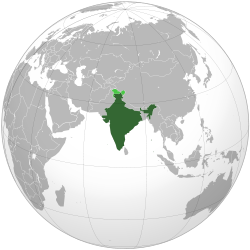- Dominion of India
-
Dominion of India
Bhārata AdhirājyaDominion of the British Commonwealth ← 
1947–1950  →
→

Flag National Emblem Capital New Delhi Language(s) Hindi, English and many others Government Constitutional Monarchy King of India - 1947-50 George VI Governor-General - 1947-48 Earl Mountbatten of Burma - 1948-50 C. Rajagopalachari Prime Minister - 1947-50 Jawaharlal Nehru Historical era Cold War - Independence 15 August 1947 - Indo-Pakistani War 1947-48 - Constitution 26 January 1950 Currency Indian rupee The Dominion of India, also known as the 'Union of India' or the 'Indian Union ', was a predecessor to modern-day India and an independent state that existed between 15 August 1947 and 26 January 1950. Although succeeded by the Republic of India, the term "Union of India" (or simply "the Union") is still used by the Indian judicial system to refer to the Indian government (as opposed to the government of the individual states).
When British rule in India ended in 1947, two dominions were created to succeed it: the Dominion of India and the Dominion of Pakistan. Created by the Indian Independence Act 1947, which was enacted by the British parliament, these states existed until the promulgation of their later republican constitutions, when the Republic of India replaced it.
During the dominion phase, the British monarch remained head of state of both countries and was represented in each by a governor-general. However, these governors-general were not also designated "Viceroys" as had been customary under the British Raj. Two governors-general held office in India during the dominion period:
- Louis Mountbatten, 1st Earl Mountbatten of Burma (1947–48)
- Chakravarti Rajagopalachari (1948–50)
Jawaharlal Nehru held office as prime minister (and head of government) of the Union of India throughout this period.
Partition of India
Main article: Partition of IndiaIn mid-August 1947 the British granted independence to two new nations in India, and both joined the British Commonwealth as self-governing dominions. The partition left Punjab and Bengal, two of the biggest provinces, divided between India and Pakistan. In the early days of independence, more than two million people migrated across the new borders and more than one hundred thousand died in a spate of communal violence. The creation of two nations divided on religious lines also resulted in tensions over the future of the princely state of Jammu and Kashmir, leading to the Indo-Pakistani War of 1947.
See also
Categories:- Former polities of the Cold War
- Former countries in South Asia
- States and territories established in 1947
- States and territories disestablished in 1950
- 1950 disestablishments
- Independent India
- Former Commonwealth realms
- India and the Commonwealth of Nations
Wikimedia Foundation. 2010.

